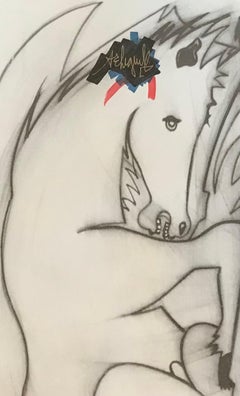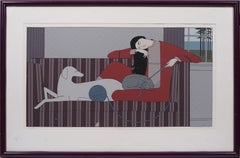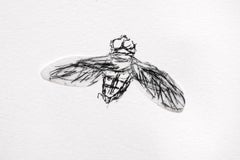Archiguille Art
French, 1932-2017
Augustin François Guille, called Archiguille (born in Alès May 17, 1932 - August 30, 2017) was a French painter.
Archiguille was born in Alès. He spent his childhood in Vendargues in the south of France during World War II under German occupation. Drawn to painting as a means of expression, he began when at school to be fascinated with the letters of the alphabet, which led in turn to forays into the oriental art of calligraphy. 1946-48 he attended the Arts and Crafts Educational Centre, Saint Jodard, Loire. In 1952 he arrived in Paris and worked at the Stamp Atelier. In 1956 he met Georges Braque. In 1957 he had his first sales with Lyrical abstraction work (a synthesis of cubism and fauvism). In 1958 he attended a course by Professor Lemagny, (Prize of Rome for painting), Fine Arts Academy.
Archiguille's first exhibition took place in 1953 at "La Librairie de l'Institut" in Paris. It showcased his passion for calligraphy with drawings of letters and spots of colors on cardboards. It was not well received at the time and turned out to be unsuccessful.
His meeting with Georges Braque in 1956 who advised him to further develop his painting skills and master a wider range of techniques was pivotal for his career's evolution. Without having a thorough grasp of figurative painting, said Braque: "you will never fully learn how to feel your art from deep within". Upon taking his advice, François Guille who was not yet called Archiguille met with Professor Lemagny (Fine Arts Academy) and refined his painting techniques under his tutelage for about two years learning to perfect his craft giving emphasis on drawings of nature and landscapes in the figurative style.
Archiguille's first canvases were much influenced by his friend Maurice Utrillo. In 1965, he held his second exposition at the Bernheim-Jeune gallery in Paris and a first success for Archiguille. His "Transfiguration" technique and avant-garde style was the theme of the art show. In 1969, he held an exhibition at the "Palais de la Radio" with the participation of Hans Hartung who was his teacher until 1968. Archiguille also admired the sensitivity with which Peter Paul Rubens and Jan Vermeer rendered effects of light. He was much influenced by Hartung and Braque who compelled him to figurative painting in order to develop a deeper inner grasp of his art.to
2
1
1
Overall Width
to
Overall Height
to
2
1
1
1
1
1
1
1
1
1
1
1
2
8,779
2,809
1,642
1,313
1
2
Artist: Archiguille
CSO Verbier 1999 by Archiguille - Print
By Archiguille
Located in Geneva, CH
Reproduction of poster against signed and numbered
30/100
Category
1990s Modern Archiguille Art
Materials
C Print
$528 Sale Price
20% Off
Abstract Composition - 96x115 cm, framed
By Archiguille
Located in Nice, FR
Oil on canvas, signed top Right
Category
Mid-20th Century Abstract Archiguille Art
Materials
Oil
$3,099 Sale Price
23% Off
Related Items
Antique American Modernist Portrait Signed Limited Edition Serigraph Interlude
By Will Barnet
Located in Buffalo, NY
Vintage American modernist interior scene by Will Barnet. Titled "Interlude". Signed and numbered limited edition from 1982.
Category
1980s Modern Archiguille Art
Materials
Screen
$1,580 Sale Price
20% Off
H 32 in W 49 in D 2 in
Kiki Smith Lithograph/Collage Various Flying Creatures "bee" Signed Dated
By Kiki Smith
Located in Detroit, MI
A collage lithograph from her series Various Flying Creatures by Kiki Smith titled: "bee." Smith has used one of her animal/insect iconic figures for this glassine paper and wove pap...
Category
1990s American Modern Archiguille Art
Materials
Paper, Lithograph
$1,500
H 19.75 in W 16.5 in
24x36 Bison American Buffalo Photography Art Poster Print Fine Art Photogrtaph
By Shane Russeck
Located in Los Angeles, CA
Museum quality archival exhibition poster print.
Dimensions: 24" x 36" sheet.
Photograph © Shane Russeck
Excellent condition (Brand new, never framed or displayed).
Category
21st Century and Contemporary American Modern Archiguille Art
Materials
Archival Ink, Archival Pigment
$36 Sale Price
20% Off
H 24 in W 36 in
Dan Burne Jones, Affection
Located in New York, NY
Dan Burne Jones is widely know as the author of the Rockwell Kent print catalogue raisonne. It's so interesting to see that he is a gifted wood engraver as well. Jones's own prints a...
Category
1930s American Modern Archiguille Art
Materials
Woodcut
Air France, Mediterranee by Roger Bezombes
By Roger Bezombes
Located in New York, NY
This lithographic poster was printed in 1981 at the Atelier Mourlot in Paris.
In the early 1970s, Air France commissioned Roger Bezombes to create original artworks capturing the s...
Category
1980s Modern Archiguille Art
Materials
Lithograph
Horse Laugh
By Alfred Bendiner
Located in New York, NY
Alfred Bendiner (1899-1964) was trained as an architect but worked as an artist throughout his career. He was a noted lithographer, as well an author, muralist, and caricaturist. The...
Category
Mid-20th Century American Modern Archiguille Art
Materials
Crayon
Mod 7
By Frank Arnold
Located in Fresno, CA
“Mod 7” is 20”x 16”. The heavy handed application of pigment renders an impasto portrait from another place in the deeper mind of the artist. Frank Arnold is one of the foremost abst...
Category
21st Century and Contemporary Abstract Archiguille Art
Materials
Canvas, Oil
Oil on Canvas “Azul Paseo”
By Frank Arnold
Located in Fresno, CA
Frank Arnold is thought by many to be one of the foremost abstract figurative painters and sculptors of our time. He is a living master whose work is considered to be both personal a...
Category
21st Century and Contemporary Abstract Archiguille Art
Materials
Oil
Randal Ford - Ayam Cemani Rooster Black Collection, 2018, Printed After
By Randal Ford
Located in Greenwich, CT
Available Sizes:
32" x 32" Edition of 15
40" x 40" Edition of 10
48" x 48" Edition of 5
Over 40,000 years ago, we began to depict animals in cave drawings. Throughout history, manki...
Category
2010s Contemporary Archiguille Art
Materials
Paper, Archival Ink, Archival Paper, Photographic Paper, C Print
Oil on Canvas "OTL 8"
By Frank Arnold
Located in Fresno, CA
“OTL 8” is 60”x 60”. Central figure of Vibrant to deep reds on a split field of warm beige/coral and deep red/black. The foreground exhibits heavy strokes and Arnold’s “8” and “X” fi...
Category
21st Century and Contemporary Abstract Archiguille Art
Materials
Canvas, Oil
Moving 5
By Frank Arnold
Located in Fresno, CA
“Moving 5” is 60”x 48”. The vibrant yellow surface tones of this piece are broken in several places allowing random glimpses of Arnold’s dreamlike underpainting for a multi-dimension...
Category
21st Century and Contemporary Abstract Archiguille Art
Materials
Canvas, Oil
Oil on Canvas “Cabo Azul 3”
By Frank Arnold
Located in Fresno, CA
“Cabo Azul 3” is 43” x 36”. Frank Arnold’s paintings exhibit the highest quality materials for a truly archival piece, created to last generations. Much of Frank Arnold’s work is so...
Category
2010s Abstract Archiguille Art
Materials
Canvas, Oil
Archiguille art for sale on 1stDibs.
Find a wide variety of authentic Archiguille art available for sale on 1stDibs. You can also browse by medium to find art by Archiguille in c print, oil paint, paint and more. Much of the original work by this artist or collective was created during the 20th century and is mostly associated with the modern style. Not every interior allows for large Archiguille art, so small editions measuring 18 inches across are available. Customers who are interested in this artist might also find the work of Robert De Launay, Roger Lersy, and René Genis. Archiguille art prices can differ depending upon medium, time period and other attributes. On 1stDibs, the price for these items starts at $330 and tops out at $2,818, while the average work can sell for $1,574.


